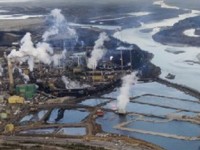Increased water monitoring of oil sands needed says Committee
 Alberta’s water
Alberta’s watermonitoring data review committee recommends comprehensive
monitoring, more rigorous scientific analysis and new monitoring
objectives in order to gain a better understanding of environmental
impacts in the oil sands region.
A committee of six independent scientists from across North America
was asked by the Premier in September 2010 to examine the data and
methodologies used by government scientists and University of
Alberta researchers Dr. Erin Kelly and Dr. David
Schindler.
After an in-depth review, the committee found
that data from the different research projects is not comparable,
because the studies had different objectives and were not designed
to examine the same potential impacts.
The committee suggests that more work is
needed to fully understand the effects of oil sands development on
the environment.
“The report reinforces the reason for our commitment to build a
better, more transparent and credible monitoring system in
Alberta,” said Environment Minister Rob Renner.
“We welcome the findings of the review committee and its
recommendations will help inform the work already underway by the
Provincial Monitoring Panel.”
The independent Provincial Monitoring Panel - created in
December 2010 - will report back to the Minister in June 2011. This
panel is designed to provide recommendations for a world-class
monitoring system, and is incorporating this data review and the
Federal Oil Sands Advisory Panel report in its deliberations.
“We want a robust system that will assure Albertans the oil
sands continue to be developed under the closest of scrutiny and
that full impacts are understood,” said Renner. “We will continue
to gather key information and guidance from respected scientists as
we build this new, world-class monitoring system.”
The panel reviewed two U of A studies, and one each from Alberta
Environment and the oilsands industry. It found industry and
government monitoring is inadequate in determining the amount of
toxins entering the environment.
“The Alberta Environment study included monitoring at a limited
number of stations, and was not specifically intended to determine
impacts from the oil sands operations,” it said.
“In the end it is not really a quest of
“who is right”, but rather, what questions were they
asking.
“The RAMP (Regional Aquatics Monitoring) program has m” any
monitoring sites, but the low sampling frequency each year limits
this program’s ability to determine impacts from oil sands
operations.”
In the end it is not really a quest of “who is right”, but
rather, what questions were they asking and how relevant were the
data collected by each group relative to their different purposes
and hypotheses to be tested, concluded the report.
“Here, we have evaluated the sufficiency of the data collected
by various groups to meet the needs of their individual mandates
and purposes. Each of the studies presents some useful information
and each suffers from some limitations.”
The full water monitoring data review committee report is
available online at
target=”_blank”>http://environment.alberta.ca/
You can return to the main Market News page, or press the Back button on your browser.

